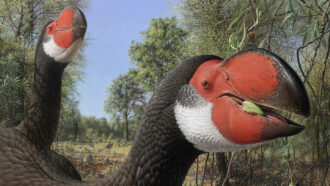
Giant flightless birds called mihirungs were the biggest birds to ever stride across what is now Australia. The animals, which weighed up to hundreds of kilograms, died out about 40,000 years ago. Now researchers might have a better idea why.
The birds may have grown and reproduced too slowly to withstand pressures from humans’ arrival on the continent, researchers report August 17 in the Anatomical Record.
Mihirungs are sometimes called “demon ducks” because of their great size and close evolutionary relationship with present-day waterfowl and game birds. The flightless, plant-eating birds lived for more than 20 million years.
Over that time, some species evolved into titans. Take Stirton’s thunderbird (Dromornis stirtoni). It lived about 7 million years ago, stood 3 meters tall and could exceed 500 kilograms in weight, making it the largest-known mihirung and a contender for the largest bird ever to live.
Most research on mihirungs has been on their anatomy and evolutionary relationships with living birds. Little is known about the animals’ biology, such as how long they took to grow and mature, says Anusuya Chinsamy-Turan, a paleobiologist at the University of Cape Town in South Africa.
So Chinsamy-Turan and colleagues at Flinders University in Adelaide, Australia took samples from 20 fossilized leg bones of D. stirtoni, from animals of varying life stages.
Paleontologist and study coauthor Trevor Worthy displays a fossilized leg bone of the “demon duck” Dromornis stirtoni (left) and a modern emu’s leg bone (right).Flinders Univ.
“Even after millions of years of fossilization, the microscopic structure of fossil bones generally remains intact,” and it can be used to decipher important clues about extinct animals’ biology, Chinsamy-Turan says.
The team examined the thin bone slices under a microscope, detailing the presence or absence of growth marks. These marks provide information on how fast the bone grew while the birds were alive.
D. stirtoni took 15 years or more to reach full size, the team found. It probably became sexually mature a few years before that, based on the timing of a shift from rapidly growing bone to a slower-growing form that’s thought to be associated with reaching reproductive age.
These results differ from the team’s earlier analysis of the bones of another mihirung, Genyornis newtoni. That species — the last-known mihirung — was less than half the size of D. stirtoni. It lived as recently as about 40,000 years ago and was a contemporary of the continent’s earliest human inhabitants. G. newtoni grew up much faster than its giant relative, reaching adult size in one to two years and growing a bit more in the following years and possibly reproducing then.
This difference in how fast mihirung species that were separated by millions of years developed may have been an evolved response to Australia developing a drier, more variable climate over the last few million years, the researchers say. When resources are unpredictable, growing and reproducing quickly can be advantageous.
Even so, that seeming pep in the developmental step of more recent mihirungs was still slower than that of the emus they lived alongside. Emus grow up quickly, reaching adult size in less than a year and reproducing not long after, laying large numbers of eggs.
This difference may explain why G. newtoni went extinct shortly after hungry humans arrived in Australia, yet emus continue to thrive today, the team says. Even though over millions of years, mihirungs as a group seem to have adapted to growing and reproducing quicker than they used to, it wasn’t enough to survive the arrival of humans, who probably ate the birds and their eggs, the researchers conclude.
“Slowly growing animals face dire consequences in terms of their reduced ability to recover from threats in their environments,” Chinsamy-Turan says.
The scientists’ research on other giant, extinct, flightless birds thought to have met their end thanks to humans — such as the dodos of Mauritius (Raphus cucullatus) and the largest of Madagascar’s elephant birds (Vorombe titan) — shows that they too grew relatively slowly (SN: 8/29/17).
“It is very interesting to see this pattern repeating again and again with many large, flightless bird groups,” says Thomas Cullen, a paleoecologist at Carleton University in Ottawa who was not involved with the new study.
Modern ratite birds seem to be the exception in their ability to handle similar pressures, he says. Other ratites besides emus that have survived until the present day — such as cassowaries and ostriches — also grow and reproduce quickly (SN: 4/25/14).

 A new treatment could restore some mobility in people paralyzed by strokes
A new treatment could restore some mobility in people paralyzed by strokes  What has Perseverance found in two years on Mars?
What has Perseverance found in two years on Mars?  This robot automatically tucks its limbs to squeeze through spaces
This robot automatically tucks its limbs to squeeze through spaces  Greta Thunberg’s new book urges the world to take climate action now
Greta Thunberg’s new book urges the world to take climate action now  Glassy eyes may help young crustaceans hide from predators in plain sight
Glassy eyes may help young crustaceans hide from predators in plain sight  A chemical imbalance doesn’t explain depression. So what does?
A chemical imbalance doesn’t explain depression. So what does?